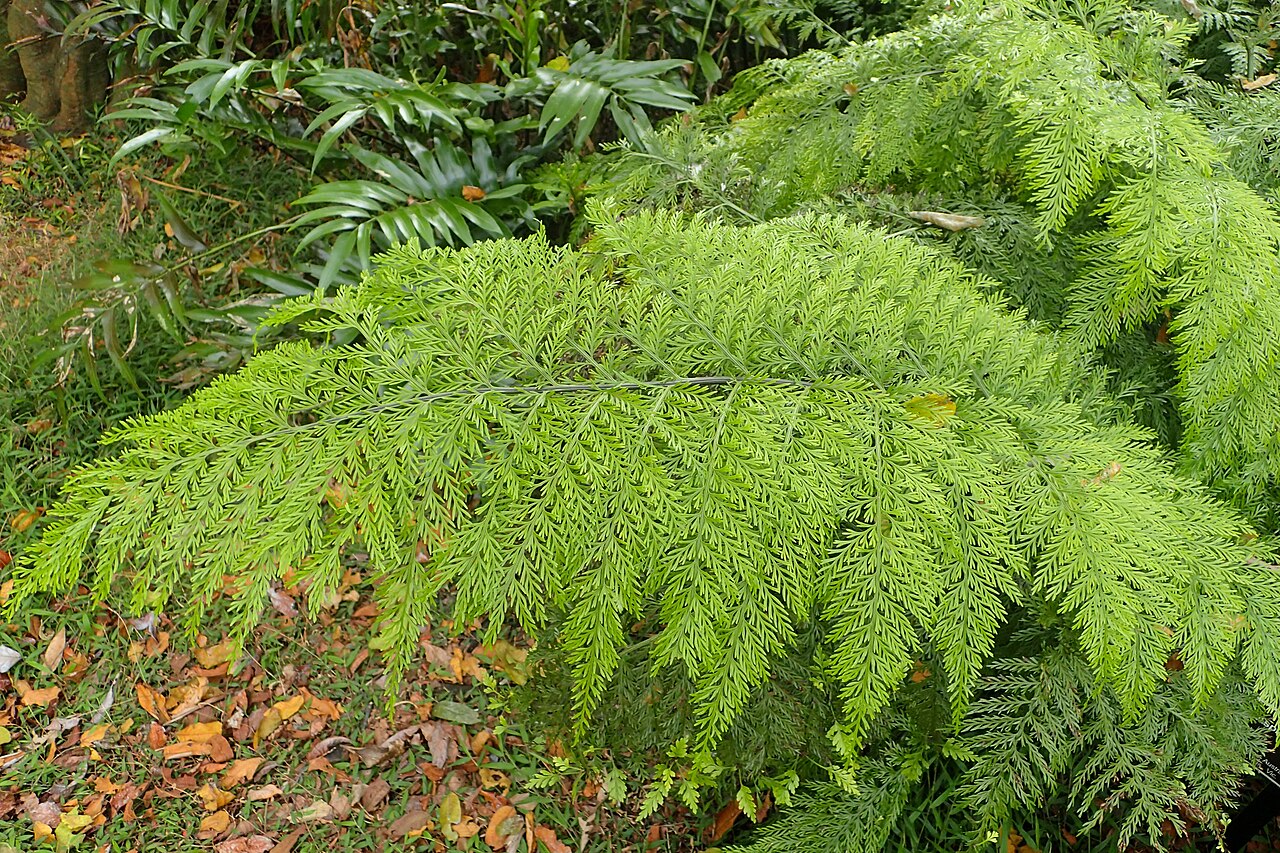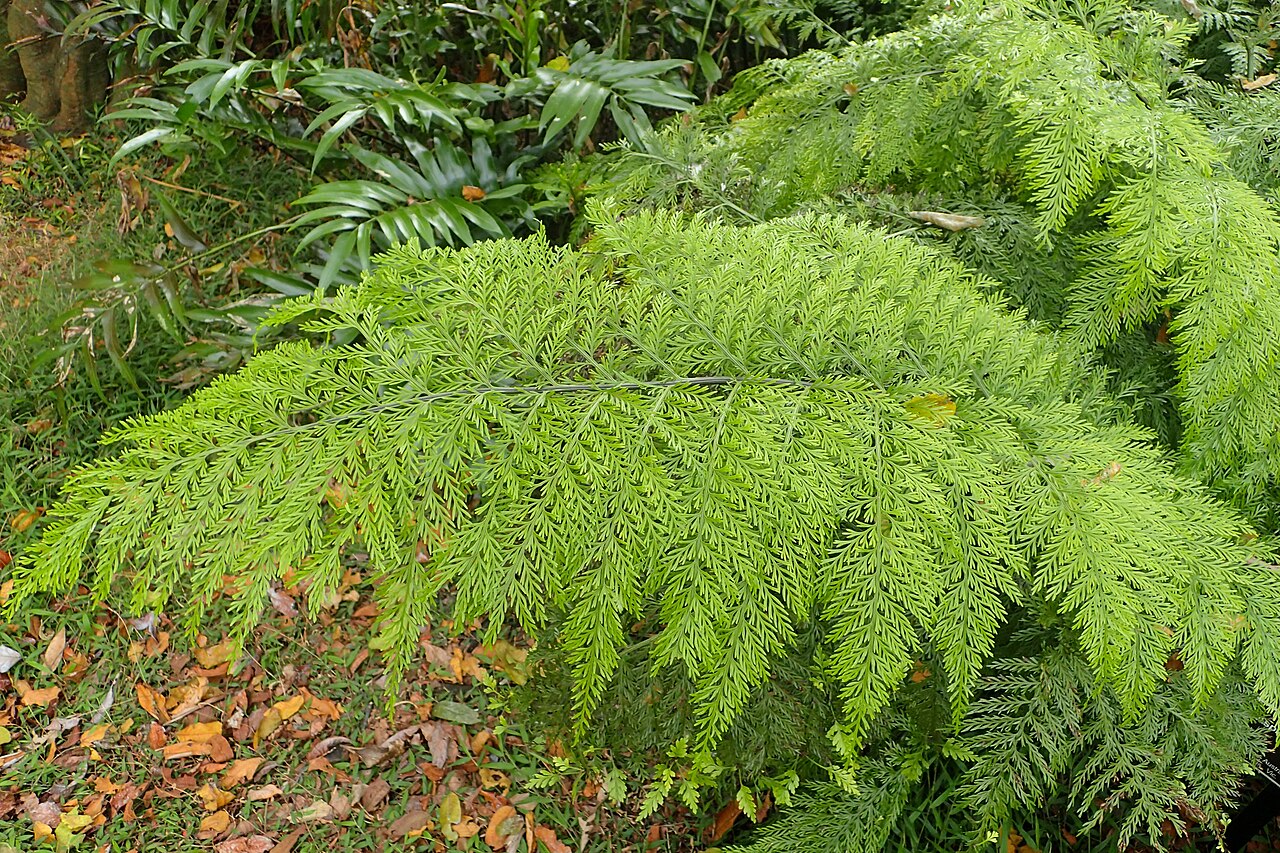Hen and Chickens Fern (Pikopiko, Manamana)
Asplenium bulbiferum
Asplenium bulbiferum, commonly known as Hen and Chickens Fern, Pikopiko, or Manamana in te reo Māori, is one of New Zealand's most distinctive and beloved native ferns. Named for its remarkable ability to produce baby plantlets (the "chickens") directly on its fronds, this adaptable fern is both a fascinating botanical curiosity and a practical choice for gardeners. The name Manamana refers to its branching fronds, and with its lush, arching form and easy propagation, it has become popular both in New Zealand and internationally.

Image credit: Wikipedia
Quick Facts
| Height | 0.5-1 meter |
|---|---|
| Water Needs | Moderate to high |
| Light | Partial to full shade |
| Frost Tolerance | Moderate |
| Growth Rate | Moderate |
| Lifespan | Long-lived perennial |
Climate Best Suited To
Hen and Chickens Fern is native to the forests of New Zealand, where it thrives in cool, moist, sheltered environments. It is found throughout the country in suitable habitats, particularly in damp, shaded areas of native bush. It prefers areas with consistent moisture and protection from direct sunlight and drying winds.
Regional Suitability
| City | Climate Suitability |
|---|---|
| Whangārei | Ideal |
| Auckland | Ideal |
| Hamilton | Ideal |
| Tauranga | Ideal |
| Rotorua | Ideal |
| Gisborne | Moderate |
| New Plymouth | Ideal |
| Napier | Moderate |
| Whanganui | Ideal |
| Palmerston North | Ideal |
| Wellington | Ideal |
| Nelson | Ideal |
| Christchurch | Moderate |
| Dunedin | Ideal |
| Invercargill | Moderate |
Growing Requirements
Soil Requirements
Hen and Chickens Fern performs best in the following soil conditions:
- Rich, humus-filled soil
- Good moisture retention
- Well-draining but consistently damp
- Slightly acidic to neutral pH (5.5-7.0)
- Benefits from added leaf mold or composted bark
- Tolerates a range of soil types if moisture is adequate
Light Requirements
This fern prefers shaded conditions:
- Dappled to deep shade
- Protection from direct sunlight, especially midday sun
- Morning sun tolerated in cooler regions
- Ideal under canopy of taller trees or shrubs
- Can tolerate more light if soil remains consistently moist
- Avoid hot, dry, exposed positions
Plantlets (Bulbils)
The easiest and most natural method:
- Wait until plantlets on fronds have developed small roots
- Either pin the frond to moist soil while still attached to parent plant
- Or carefully remove plantlets from frond
- Plant directly into small pots with moist potting mix
- Keep consistently moist and in high humidity
- Protect from direct sun and wind
- Plantlets will establish in 4-8 weeks
- Transplant to larger containers or garden when well-rooted
Division
For creating larger plants more quickly:
- Best done in early spring as new growth begins
- Carefully remove plant from pot or garden
- Gently divide the rootball into sections
- Ensure each section has several fronds and healthy roots
- Replant divisions at the same depth as original plant
- Water thoroughly and keep consistently moist
- Protect from direct sun and wind until established
Spores
For those wanting a challenge:
- Collect fertile fronds when spore cases (sori) turn brown
- Place fronds on clean paper in a warm, dry place for 1-2 days
- Collect the fine, dust-like spores that fall onto the paper
- Prepare a sterile growing medium of peat and perlite
- Sprinkle spores thinly over the surface
- Cover with glass or plastic to maintain humidity
- Keep at 18-21°C (65-70°F) in indirect light
- Mist with distilled water to maintain moisture
- Prothalli will form in 1-3 months
- Young ferns will develop in 6-12 months
- Transplant when several fronds have formed
Uses & Significance
Garden Uses
- Shade gardens
- Indoor plant
- Rock gardens
- Native gardens
- Hanging baskets
Cultural Significance
- Traditional food source (pikopiko)
- Medicinal uses in rongoā Māori
- Indicator of forest health
- Part of traditional ecological knowledge
Ecological Value
- Forest understory species
- Provides shelter for small invertebrates
- Soil stabilization
- Indicator of healthy forest ecosystems
Seasonal Care Calendar
Spring
- New fronds begin to emerge
- Clean up any dead fronds
- Good time for division
- Monitor for pests
Summer
- Maintain consistent moisture
- Protect from hot afternoon sun
- Watch for spider mites in dry conditions
- Harvest pikopiko (young fronds) if desired
Autumn
- Reduce watering frequency
- Clean up fallen debris
- Good time for planting
- Check for spore production
Winter
- Minimal watering needed
- Protect from frost in cold areas
- Remove any damaged fronds
- Monitor for slug damage
When to Prune and How Much
Hen and Chickens Fern requires minimal pruning, mainly for maintenance and appearance:
- Remove dead, damaged, or diseased fronds at any time
- Cut old fronds at the base, close to the crown
- Trim away plantlets if they become too numerous
- Clean up fallen debris to prevent disease
- Use clean, sharp tools to prevent infection
Always sterilize tools between plants to prevent the spread of disease. Avoid cutting into the crown or rhizome when pruning.
Planting Guide
When to Plant
The best time to plant Hen and Chickens Fern is during spring or autumn when temperatures are mild and rainfall is more reliable. This gives the plant time to establish before extreme weather conditions.
Site Selection
Choose a site with:
- Dappled to full shade
- Rich, well-draining soil
- Protection from strong winds
- High humidity
- Sheltered position
Planting Procedure
- Prepare a hole twice the width of the root ball
- Mix compost into the planting soil
- Plant at the same level as it was growing in the container
- Water thoroughly after planting
- Apply a layer of mulch around the plant
- Keep soil consistently moist until established
Initial Care
Water regularly during the first growing season, especially during dry periods. Protect from direct sun and strong winds until established. Monitor for signs of stress or pest problems.
Propagation Methods
From Spores
Growing from spores requires patience but can produce many plants:
- Collect mature fronds with dark spore cases
- Place in paper bag to collect spores
- Sow on sterile, moist growing medium
- Keep warm (20-25°C) and humid
- Expect germination in 4-6 weeks
- Transplant when prothalli develop
From Plantlets
The easiest method, using the naturally occurring plantlets:
- Wait for plantlets to develop roots while still attached
- Cut plantlet from parent frond with roots attached
- Plant in small pot with moist potting mix
- Keep humid until established
- Transplant when roots are well developed
By Division
For established plants:
- Divide in spring before new growth
- Ensure each division has roots and several fronds
- Replant immediately at original depth
- Keep well-watered until established
Cultural History
Hen and Chickens Fern, known as Manamana to Māori, has a significant place in New Zealand's natural and cultural heritage:
Traditional Māori Uses
- Known as "pikopiko" or "manamana" in te reo Māori, with manamana referring to its distinctive branching form
- Young unfurling fronds (koru) of manamana harvested as a food source
- Considered a delicacy and still used in contemporary Māori cuisine
- Used in traditional medicine for various ailments
- Featured in traditional stories and as a symbol of new life and growth
Ecological Significance
- Important component of native forest understories
- Provides habitat for small invertebrates
- Contributes to forest biodiversity
- Helps prevent soil erosion on forest floors
- Unique propagation method allows rapid colonization of suitable habitats
European Settlement Impact
- Documented by early European botanists
- Habitat reduced through forest clearance
- Collected for Victorian-era fern gardens and terrariums
- Exported internationally as a curiosity
- Specimens sent to European botanical gardens
Contemporary Significance
Today, Hen and Chickens Fern is valued both for its ecological role in native forests and as an ornamental plant in gardens worldwide. Its unique propagation method makes it popular for educational purposes, and its edible fronds feature in New Zealand cuisine. Conservation efforts include preserving its natural habitat in protected forest areas and sustainable harvesting practices for food use.
Pests & Diseases
Common Pests
- Scale Insects: May appear on fronds as small bumps. Remove with cotton swab dipped in alcohol or use horticultural oil.
- Slugs and Snails: Often damage new fronds. Control with organic baits, copper tape, or beer traps.
- Caterpillars: Occasionally feed on fronds. Hand-pick or use organic Bacillus thuringiensis spray if infestation is severe.
- Mealybugs: Sometimes infest the crown and base of fronds. Treat with insecticidal soap or neem oil.
Common Diseases
- Root Rot: Caused by overwatering or poor drainage. Ensure well-draining soil and avoid waterlogged conditions.
- Crown Rot: Often results from water sitting in the crown. Avoid overhead watering and ensure good air circulation.
- Fungal Leaf Spots: Various fungi can cause spotting on fronds. Improve air circulation and avoid overhead watering.
- Powdery Mildew: May appear as white powder on fronds. Improve air circulation and treat with fungicide if severe.
Environmental Issues
- Desiccation: Low humidity causes frond edges to brown and curl. Increase humidity with misting or mulching.
- Sunburn: Direct sunlight causes yellowing and browning of fronds. Move to a more shaded location.
- Frost Damage: Severe frosts can damage fronds. Protect with frost cloth during cold snaps.
- Wind Damage: Strong winds can tatter fronds. Plant in sheltered locations or provide windbreaks.
Hen and Chickens Fern is generally resilient to pests and diseases when grown in appropriate conditions. Good cultural practices including proper spacing, appropriate watering, and good air circulation will prevent most problems. This fern is more susceptible to environmental stress than pest or disease issues, so focus on providing the right growing conditions.
Bonus Tip
Create a native fern collection by pairing Hen and Chickens Fern with other shade-loving native ferns like Blechnum discolor (Crown Fern) and Asplenium oblongifolium (Shining Spleenwort). Plant them in a shaded area with rich, well-draining soil and add some native ground covers like Pratia angulata for contrast. This combination creates a beautiful, low-maintenance native garden that provides year-round interest and supports local biodiversity.



